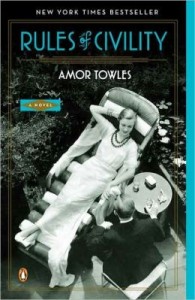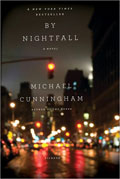 Amor Towles’ debut novel, Rules of Civility is a captivating period piece that takes place in New York City, particularly in Manhattan. The story begins in 1966 but quickly turns back to New Year’s Eve, 1939.
Amor Towles’ debut novel, Rules of Civility is a captivating period piece that takes place in New York City, particularly in Manhattan. The story begins in 1966 but quickly turns back to New Year’s Eve, 1939.
Kate Kontent and her roommate Eve meet wealthy Tinker Gray at a jazz club on New Year’s Eve. A solid friendship forms and the three of them share many enjoyable times together. An accident abruptly changes their relationship and the direction of their lives.
Kate, who narrates the novel, is at first in a secretarial pool at a successful law firm, but quickly moves on to become a secretary at a trendy magazine. The daughter of a Russian immigrant, she never denies her background and that she is among “the working class,” but finds herself socializing with a privileged group of people (white, rich and sophisticated). Kate, extremely well-read and intelligent, remains grounded, but finds herself involved in the social activities of the well-to-do with their well-kept secrets and expensive life-style.
As we ride along with Kate, we learn about the lives of the New York rich. The book takes place toward the end of the depression and the wealthy portrayed don’t seem to have suffered unduly. It’s an era of surprisingly aimless goals among the rich, smoking, drinking martinis, rarely cooking one’s own meal, living exclusively in apartments, and commuting in cabs or chauffeured limousines. The dialog is fast-paced and witty, the sense of New York rich in detail.
Rules of Civility takes its name after the 110 rules that George Washington crafted during his teenage years, “Rules of Civility & Decent Behaviour in Company and Conversation.” Towles ends the book with the complete list of rules, often mentioned in the novel as either rules to be followed in a civilized society, or possibly rules no longer relevant. Here’s Washington’s 6th Rule of Civility:
“Sleep not when others Speak, Sit not when others stand, Speak not when you Should hold your Peace, walk not on when others Stop.”
I enjoyed Rules of Civility. I marveled at the differences between New York and the mid-west or west. The novel concentrates on either the very rich and the poor working class. There must have been some “middle class” but this novel does not touch on what most of us recognize as normal. The author’s descriptions of scenes and scenery feel realistic and vibrant. The book gave me a glimpse of an era and place now changed forever. I recommend Rules of Civility and look forward to reading more of this author’s work.


